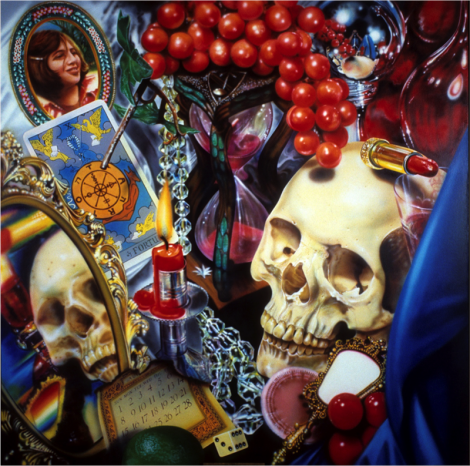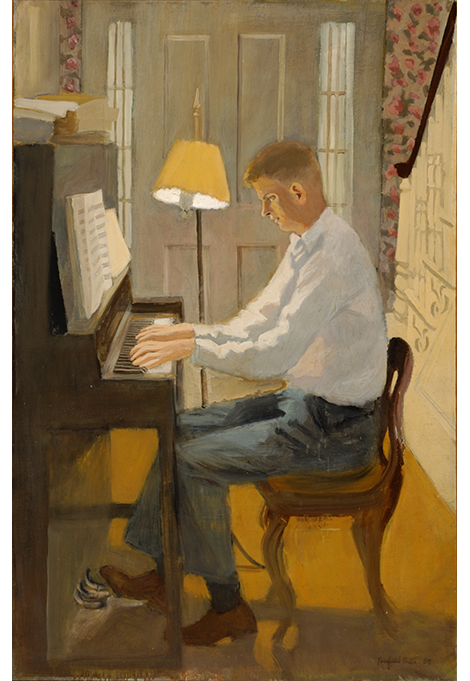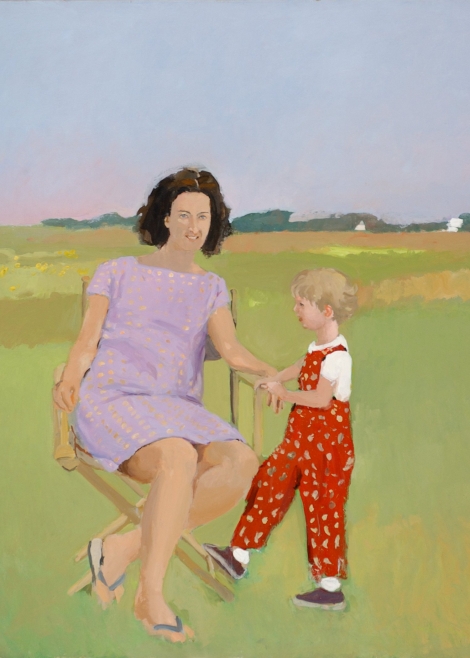Picture is a two-part thematic exhibition featuring important recent acquisitions of paintings by David Salle and Photorealist artists. In 2004, Salle was commissioned for Museo Carlo Bilotti, Rome, to address a single subject: the Sistine Chapel. In three monumental paintings—After Michelangelo, The Creation; After Michelangelo, The Flood; and After Michelangelo, The Last Judgment (2005–2006)—the artist upends the source material by juxtaposing figures depicted in Michelangelo’s paintings with vignettes and illustrative images of objects from modern times and recent history. In The Flood, Salle updates the biblical story of the deluge in the book of Genesis with references to natural disasters including the 2004 tsunami in Asia and Hurricane Katrina. In The Last Judgement, figures from Michelangelo’s fresco are overtaken by images of doom and destruction: missiles, Satan, and a scythe-wielding personification of death. The paintings were gifted to the Museum by Margaret S. Bilotti.
Photorealism paintings, in which ready-made images are used in the service of often abstract narratives, provide a provocative context to the conversation about representation and imagery. New acquisitions by Tom Blackwell and Bertrand Meniel introduce a dialogue about the relationship of interior and exterior space that mirrors the Parrish’s architectural design, while paintings by Ron Kleemann, Yigal Ozeri, Charles Bell, and Audrey Flack balance complex composition with suggested narratives. In Blackwell’s Morning Walk, Hampstead High Street, London,2011, the viewer looks into a store window at two inanimate figures and sees reflections of people and cars on the street, thus creating a visual doubling that creates a dialogue between inside and outside. Meniel’s Breakfast at the Fairmont, 2009, depicts grand urban architecture contrasted with archetypal images of the natural world—mountains and the sea. This concept is underscored in the Parrish architecture, where broad panes of glass, slit windows, and skylights encourage visitors to sense the connection of art to nature.
Into the Artist’s World: The Photographs of Fred W. McDarrah
For more than 50 years, photographer Fred W. McDarrah (American, 1926–2007) chronicled New York post-war culture through his images published in the Village Voice. Into the Artist’s World presents 27 recently acquired photographs by McDarrah of artists who lived, worked, or visited the East End of Long Island and contributed to the region’s rich creative legacy. Dating from 1959 to1979, the images includes Norman Bluhm, James Brooks, Elaine de Kooning, Willem de Kooning, Roy Lichtenstein, and Robert Motherwell—all of whom are represented in the Parrish permanent collection. Works by the artists themselves bring their portraits alive.
Louisa Chase: Below the Surface
This survey features 18 paintings and works on paper dating from 1972–2011 by the artist who provided a view into the diary of her inner life through the bold use of color in her abstract works. Organized in cooperation with the Louisa Chase Estate, Below the Surface includes Yellow Spooks, 1986; and Untitled, 1988, two paintings in the Parrish collection, in a compendium of works on paper and large-scale paintings that provides an in-depth look at the artist’s creative approach.
Fairfield Porter Raw: The Creative Process of an American Master
Fairfield Porter (American, 1907–1975), painted a personal story: the world immediately surrounding him. Portraits of family and friends, his studio and homes in Spruce Head Island, Maine, and Southampton, New York bring together authentic lived experiences and art in a visual autobiography. Fairfield Porter Raw includes both finished artwork and others in various stages of development, revealing his creative process and working method.
William Merritt Chase: The Shinnecock Years
William Merritt Chase (1849–1916) painted the Shinnecock Hills on the East End of Long Island beginning in 1891 and founded the Shinnecock Hills Summer School of Art. The exhibition features works by the artist and his students, augmented by archival photographs dating from 1890–1910 from the book Time and History by Shinnecock historian David Bunn Martine. The portraits of Shinnecock Indian Nation members who worked for the Chase family and the art school society—including the women who grew produce and functioned as laundresses, and the men who served as fishing and hunting guides—reveal the unexpected story of the impact of Chase’s ties within the community.
A Fresh Look: The Collection in Conversation
Aesthetically, black and white provides for emphatic graphic abstraction, but also nuanced approaches to both representation and abstraction. These concepts are illustrated in the thematically-organized gallery, featuring largely abstract paintings and sculpture that explore the nuance between dark and light through works by Alice Aycock, Louise Nevelson, Donald Sultan, and others.
Every Picture Tells a Story, the 2018 Permanent Collection Exhibition, has been made possible, in part, by the generous support of Barbara Slifka; Ellen Cantrowitz, Garrett and Mary Moran; Charlotte Moss and Barry Friedberg, Jane and David Walentas, Marie Samuels, Per Skarstedt, Deborah Buck, and a donor who wishes to remain anonymous.










